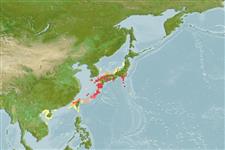>
Syngnathiformes (Pipefishes and seahorses) >
Syngnathidae (Pipefishes and seahorses) > Syngnathinae
Etymology: Hippocampus: Greek, ippos = horse + Greek,kampe = curvature (Ref. 45335); japapigu: Name from the colloquial Japanese name, Japapigu or Japan pig or 日本のピグミータツノオトシゴ.
Environment: milieu / climate zone / depth range / distribution range
Ekologi
laut berasosiasi dengan karang; kisaran kedalaman 5 - 22 m (Ref. 118476), usually 10 - 13 m (Ref. 118476). Subtropical
Northwestern Pacific: Japan and Chinese Taipei.
Size / Weight / umur
Maturity: Lm ? range ? - ? cm
Max length : 1.6 cm SL jantan/; (Ref. 118476)
deskripsi pendek
Kunci identifiaksi (pengenalan) | Morfologi | Morfometrik
duri punggung lunak (Keseluruhan (total)) : 14. This species is distinguished from its congeners by the following set of characters: 28 tail rings; 14 dorsal fin rays; 9 pectoral fin rays; 4 subdorsal rings; bilaterally paired wing-like protrusions are formed by a pair of large truncate spines projecting laterad on first superior trunk ridge; elevated dorsal ridge is formed by unique triangular bony mounds dorsally on second, the third and fourth trunk rings with the posterior mound less pronounced; a large and prominent spine projecting laterad on eighth lateral trunk ridge (Ref. 118476).
This species was not associated with a particular host. It has been observed in association with mixed soft coral, Halimeda sp. (coralline algae) and hydroids on rocky reef walls and large boulders in both exposed and semi-sheltered locations (Ref. 118476)..
Life cycle and mating behavior
Kematangan | Reproduksi, perkembang biakan | Pemijahan | telur-telur | Fecundity | Larva
Short, G., R. Smith, H. Motomura, D. Harasti and H. Hamilton, 2018. Hippocampus japapigu, a new species of pygmy seahorse from Japan, with a redescription of H. pontohi (Teleostei, Syngnathidae). ZooKeys 779:27-49. (Ref. 118476)
Status IUCN Red List (Ref. 130435: Version 2024-2)
ancaman kepada manusia
Harmless
penggunaan manusia
Alat, peralatan
laporan khas
muat turun XML
Sumber internet
Estimates based on models
Phylogenetic diversity index (Ref.
82804): PD
50 = 0.5000 [Uniqueness, from 0.5 = low to 2.0 = high].
Bayesian length-weight: a=0.00447 (0.00175 - 0.01142), b=2.99 (2.77 - 3.21), in cm total length, based on LWR estimates for this (Sub)family-body shape (Ref.
93245).
Trophic level (Ref.
69278): 3.0 ±0.5 se; based on size and trophs of closest relatives
Daya lenting (Ref.
120179): Tinggi, Waktu penggandaan populasi minimum kurang dari 15 bulan (Preliminary K or Fecundity.).
Fishing Vulnerability (Ref.
59153): Low vulnerability (10 of 100).
